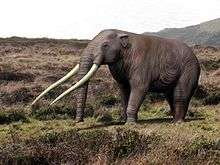Anancidae
The Anancidae are an extinct family of large herbivorous mammals that were closely related to modern elephants. They were assigned to the Gomphotheriidae in the past, but recent authors consider them a distinct family.[1][2][3] Under the Gomphotheriidae sensu lato, they were known as the tetralophodont gompotheres based on their molar morphology.
| Anancidae | |
|---|---|
 | |
| Life reconstruction of Anancus arvernensis | |
| Scientific classification | |
| Kingdom: | Animalia |
| Phylum: | Chordata |
| Class: | Mammalia |
| Order: | Proboscidea |
| Superfamily: | Elephantoidea |
| Family: | †Anancidae Hay, 1922 |
| Genera | |
| |
References
- J. Shoshani and P. Tassy. 2005. Advances in proboscidean taxonomy & classification, anatomy & physiology, and ecology & behavior. Quaternary International 126-128:5-20
- J. Shoshani and P. Tassy. 1996. Summary, conclusions, and a glimpse into the future. in J. Shoshani and P. Tassy, eds., The Proboscidea: Evolution and Palaeoecology of Elephants and Their Relatives 335-348
- Mothé D, Ferretti MP, Avilla LS (2016) "The Dance of Tusks: Rediscovery of Lower Incisors in the Pan-American Proboscidean Cuvieronius hyodon Revises Incisor Evolution in Elephantimorpha". PLoS ONE 11(1): e0147009. doi:10.1371/journal.pone.0147009
This article is issued from Wikipedia. The text is licensed under Creative Commons - Attribution - Sharealike. Additional terms may apply for the media files.